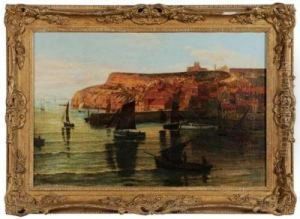Edward Richard Taylor Paintings
Edward Richard Taylor was a pivotal figure in the late 19th and early 20th-century British art scene, known primarily for his contributions to pottery and as an educator in the field of art. Born in 1838, Taylor embarked on a career that would see him play a significant role in the Arts and Crafts Movement, a key moment in the history of decorative arts, which sought to elevate craftsmanship amidst the industrialization of production.
Taylor's journey into the arts began with an education that emphasized the importance of drawing and design, principles that would underpin his entire career. In the 1870s, he became headmaster of the Birmingham School of Art, a position through which he profoundly influenced the direction of art education in Britain. Under his guidance, the school became a beacon of the Arts and Crafts philosophy, promoting the idea that art should meet the needs of society and that beauty and functionality were not mutually exclusive.
Besides his educational endeavors, Edward Richard Taylor was also deeply involved in the world of pottery, a field in which he made significant contributions. In 1875, he co-founded the Birmingham Guild and School of Handicrafts, an institution that became synonymous with high-quality, handcrafted items, including metalwork, jewelry, and pottery. Taylor's work in pottery, in particular, is noted for its innovative designs and the revival of traditional techniques that had been lost to industrial manufacturing processes.
Taylor's influence extended beyond his immediate professional circles. His ideas and practices were instrumental in shaping the Arts and Crafts Movement, not just in Birmingham but across Britain and beyond. His commitment to art education and his belief in the value of handcraftsmanship helped to foster a new appreciation for the role of the artist in society and the importance of quality in production.
Edward Richard Taylor passed away in 1912, but his legacy lives on through his contributions to art education and the Arts and Crafts Movement. His work helped to lay the foundations for modern design education and continues to inspire those who value the intersection of beauty, functionality, and craftsmanship in the arts.
